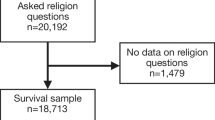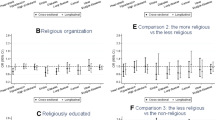Abstract
Very few studies have examined the effects of both religious affiliation and religiosity on mortality at the same time, and studies employing multiple dimensions of religiosity other than religious attendance are rare. Using the newly created General Social Survey-National Death Index data, our report contributes to the religion and mortality literature by examining religious affiliation and religiosity at the same time. Compared to Mainline Protestants, Catholics, Jews, and other religious groups have lower risk of death, but Black Protestants, Evangelical Protestants, and even those with no religious affiliation are not different from Mainline Protestants. While our study is consistent with previous findings that religious attendance leads to a reduction in mortality, we did not find other religious measures, such as strength of religious affiliation, frequency of praying, belief in an afterlife, and belief in God to be associated with mortality. We also find interaction effects between religious affiliation and attendance. The lowest mortality of Jews and other religious groups is more apparent for those with lower religious attendance. Thus, our result may emphasize the need for other research to focus on the effects of religious group and religious attendance on mortality at the same time.
Similar content being viewed by others
References
Carr, D., & Sharp, S. (2013). Do afterlife beliefs affect psychological adjustment to late-life spousal loss? Journal of Gerontology: Psychological Sciences and Social Sciences. doi: 10.1093/geronb/gbt063. First published online: June 29, 2013.
Chaves, M. (2011). American religion. Princeton: Princeton University Press.
Chida, Y., Steptoe, A., & Powell, L. H. (2009). Religiosity/spirituality and mortality a systematic quantitative review. Psychotherapy and Psychosomatics, 78(2), 81–90.
Cleves, M., Gutierrez, R. G., Gould, W., & Marchenko, Y. V. (2010). An introduction to survival analysis using stata. College Station, Texas: Stata.
Cornwall, M., Albrecht, S. L., Cunningham, P. H., & Pitcher, B. L. (1986). The dimensions of religiosity: A conceptual model with an empirical test. Review of Religious Research, 27(3), 226–244.
Ellison, C., & Levin, J. S. (1998). The religion-health connection: Evidence, theory, and future directions. Health education and Behavior, 25(6), 700–720.
Gillum, R. F., King, D. E., Obisesan, T. O., & Koenig, H. G. (2008). Frequency of attendance at religious services and mortality in a U.S. national cohort. Annals of Epidemiology, 18(2), 124–129.
Goldstein, S. (1996). Changes in Jewish mortality. Social Biology, 43(1–2), 72–97.
Greeley, A. M., & Hout, M. (1999). Americans’ increasing belief in life after death: Religious competition and acculturation. American Sociological Review, 64(6), 813–835.
Greenfield, E. A., & Marks, N. F. (2007). Religious social identity as an explanatory factor for associations between more frequent formal religious participation and psychological well-being. The International Journal for the Psychology of Religion, 17(3), 245–259.
Harrigan, J. T. (2011). Health promoting habits of people who pray for their health. Journal of Religion and Health, 50(3), 602–607.
Helm, H. M., Hays, J. C., Flint, E. P., Koenig, E. P., & Blazer, D. G. (2000). Does private religious activity prolong survival? A six-year follow-up study of 3,851 older adults. Journal of Gerontology: Medical Sciences, 55(7), M400–M405.
Hill, T. D., Burdette, A. M., & Idler, E. L. (2011). Religious involvement, health status, and mortality risk. In R. A. Settersten & J. L. Angel (Eds.), Handbook of sociology of aging (pp. 533–546). New York: Springer.
Hogg, M. A. (2006). Social identity theory. In P. J. Burke (Ed.), Contemporary social psychological theories (pp. 111–136). Stanford, CA: Stanford University Press.
Hogg, M. A., Adelman, J. R., & Blagg, R. D. (2010). Religion in the face of uncertainty: An uncertainty-identity theory account of religiousness. Personality and Social Psychology Review, 14(1), 72–83.
Hummer, R. A., Ellison, C. G., Rogers, R. G., Moulton, B. E., & Romero, R. R. (2004). Religious Involvement and adult mortality in the United States: Review and perspective. Southern Medical Journal, 97(12), 1223–1230.
Hummer, R. A., Rogers, R. G., Nam, C. B., & Ellison, C. G. (1999). Religious involvement and U.S. adult mortality. Demography, 36(2), 273–285.
Iannaccone, L. R. (1994). Why strict churches are strong. American Journal of Sociology, 99(5), 1180–1211.
Idler, E. L. (2011). Religion and adult mortality: Group- and individual-level perspectives. International handbook of adult mortality (pp. 345–377). New York: Springer.
Jarvis, G. K., & Northcott, H. C. (1987). Religion and differences in morbidity and mortality. Social Science and Medicine, 25(7), 813–824.
Kass, J. D., Friedman, R., Leserman, J., Zuttermeister, P. C., & Benson, H. (1991). Health outcomes and a new index of spiritual experience. Journal for the Scientific Study of Religion, 30(2), 203–211.
Koenig, H., King, D., & Carson, V. B. (2012). Mortality. Handbook of religion and health (2nd ed., pp. 468–491). Oxford: Oxford University Press.
Koenig, H., McCullough, M. E., & Larson, D. B. (2001). Mortality. Handbook of Religion and Health (pp. 318–330). Oxford: Oxford University Press.
Levin, J. (2001). God, faith, and health. New York: Wiley.
Levin, J., Chatters, L. M., & Taylor, R. J. (2011). Theory in religion, aging, and health: An overview. Journal of Religion and Health, 50(2), 389–406.
Levin, J. S., & Schiller, P. I. (1987). Is there a religious factor in health? Journal of Religion and Health, 26(1), 9–35.
Lucchetti, G., Lucchetti, A. L. G., & Koenig, H. G. (2011). Impact of spirituality/religiosity on mortality: Comparison with other health interventions. Explore-The Journal of Science and Healing, 7(4), 234–238.
McCullough, M. E., Hoyt, W. T., Larson, D. B., Koenig, H. G., & Thoresen, C. (2000). Religious involvement and mortality: A meta-analytic review. Health Psychology, 19(3), 211–222.
Moulton, B. E., & Sherkat, D. E. (2012). Specifying the effects of religious participation and educational attainment on mortality risk for US adults. Sociological Spectrum, 32(1), 1–19.
Muennig, P., Johnson, G., Kim, J., Smith, T. W., & Rosen, Z. (2011). The General Social Survey-National Death Index: An innovative new dataset for the social sciences. BMC Research Notes, 4, 385.
Musick, M. A., House, J. S., & Williams, D. R. (2004). Attendance at religious services and mortality in a national sample. Journal of Health and Social Behavior, 45(2), 198–213.
Nicholson, A., Rose, R., & Bobak, M. (2010). Associations between different dimensions of religious involvement and self-rated health in diverse European populations. Health Psychology, 29(2), 227–235.
Oman, D., Kurata, J. H., Strawbridge, W. J., & Cohen, R. D. (2002). Religious attendance and cause of death over 31 years. International Journal of Psychiatry in Medicine, 32(1), 69–89.
Paragament, K. I. (2002). The bitter and the sweet: An evaluation of the costs and benefits of religiousness. Psychological Inquiry: An International Journal for the Advancement of Psychological Theory, 13(3), 168–181.
Ploch, D. R., & Hastings, D. W. (1994). Graphic presentations of church attendance using General Social Survey Data. Journal for the Scientific Study of Religion, 33(1), 16–33.
Powell, L. H., Shahabi, L., & Thoresen, C. E. (2003). Religion and spirituality: Linkages to physical health. The American Psychologist, 58(1), 36–52.
Rippentrop, A. E., Altmaier, E. M., Chen, J. J., Found, E. M., & Keffala, V. J. (2005). The relationship between religion/spirituality and physical health, mental health, and pain in a chronic pain population. Pain, 116, 311–321.
Sharp, S. (2010). How does prayer help manage emotions? Social Psychological Quarterly, 73(4), 417–437.
Silton, N., Flannelly, K. J., Galek, K., & Ellison, C. G. (2013). Beliefs about god and mental health among American adults. Journal of Religion and Health,. doi:10.1007/s10943-013-9712-3.
Smith, T. W., Marsden, P., Hout, M., & Kim, J. (2011). General social surveys, 1972–2010: Cumulative codebook. Chicago: NORC.
Steensland, B., Park, J. Z., Regnerus, M. D., Robinson, L. D., Wilcox, W. B., & Woodberry, R. D. (2000). The measure of American religion: Toward improving the state of the art. Social Forces, 79(1), 291–318.
Strawbridge, W. J., Cohen, R. D., Shema, S. J., & Kaplan, G. A. (1997). Frequent attendance at religious services and mortality over 28 years. American Journal of Public Health, 87(6), 957–961.
Sullivan, A. R. (2010). Mortality differentials and religion in the United States: Religious affiliation and attendance. Journal for the Scientific Study of Religion, 49(4), 740–753.
Author information
Authors and Affiliations
Corresponding author
Rights and permissions
About this article
Cite this article
Kim, J., Smith, T.W. & Kang, Jh. Religious Affiliation, Religious Service Attendance, and Mortality. J Relig Health 54, 2052–2072 (2015). https://doi.org/10.1007/s10943-014-9902-7
Published:
Issue Date:
DOI: https://doi.org/10.1007/s10943-014-9902-7




